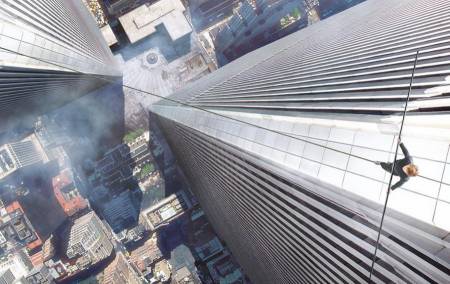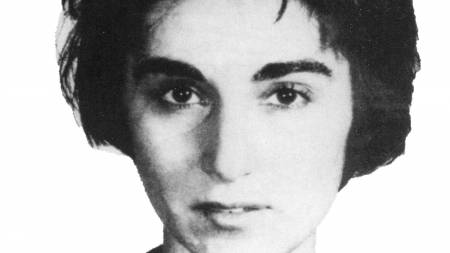ROBERT ZEMECKIS: THE WALK (2015)
Image from The Walk
High above Seventies NYC on a wire -- a time when CGI and 3D make perfect sense
It happened early in the morning of 7 August 1974. Philippe Petit, the French high wire performer, then just short of his twenty-fifth birthday, appearing out of nowhere in lower Manhattan atop the highest buildings in the city of New York, carried out the greatest exploit of his career. Working with accomplices, he secretly strung a wire between corners of the Twin Towers of the World Trade Center, then barely completed, and astonished the world by walking back and forth gently and playfully between them, eight passes, in the stratosphere, an act of sublime beauty and insane boldness. This was done illegally. He did not have a permit, and had he applied he wold never have got one. It was a bold and secret operation. It was also a dazzling performance, a work of art, a reaching for the infinite and the void and a defiance of death.
It is astonishing and thrilling to contemplate this exploit. James Marsh's wonderful 2008 documentary Man on Wire allows us to do that and explores how Petit did it in the greatest detail, filling us in on his life, his training, the long planning and practice, his collaborators, and his loves and the materials used, how they were spirited into the building and up to the rooftops -- all of that is in Marsh's film. Why should Zemeckis want to make a feature film about it? Two reasons, basically: Joseph Gordon-Levitt and 3D (plus CGI). Joe is a bold and confident young actor (not as young as Petit was, but that's okay) -- bold enough to speak French convincingly in the film and narrate it all through standing on the Statue of Liberty's torch (working from Petit's memoir, To Reach the Clouds) with a plausible fake French accent, which is pretty much a tightrope act in itself. He carries it off. He looks and sounds convincing. And he does the high wire walking, or a lot of it, himself, and beautifully.
The thing that Marsh's fine documentary could not do is show "The Walk" in motion from above. There is no actual film footage of Petit's "coup," only stills. Zemeckis provides us with a dazzling bird's eye view of Petit walking on the wire with the city below -- in 3D. I've never been a fan of 3D. But when we get to the spectacular shots of the wire, the man, the Towers, and the city below recreated in CGI, this format makes sense and greatly enhances what is most essential, the sense of space the breathtaking, scrotum- tightening excitement of The Walk -- or as Petit calls it, "the coup," as elegantly depicted in the film. This is a movie making a wild dream come true, and Zemeckis' use of current film technology simply realizes the dream.
Along the way, there are good performances and much Seventies atmosphere through recreated New York cityscape, men's hairstyles and clothes. Notable among the subsidiary performances are Ben Kingsley as Papa Rudy, the tight-rope mentor, and Charlotte Le Bon as Annie, Petit's girlfriend and collaborator of the time who, however, went back to France when the exploit was over and Petit decided to remain in New York. Gordon-Levitt begins the film (after a sequence of young Philippe played by Soleyman Pierini) showing Petit's life as a juggler and street performer in Paris who made international news by tightrope-walking across the towers of Notre Dame. But the overriding topic is the Twin Towers walk. Don't expect more. It should be enough. (See Debruge's Variety review for details of the accomplices and the actors who play them. Debruge feels the iMax film slights details in the wire-to-ground shots. I was looking at the space, and did not care.)
Joseph Gordon-Levitt, who is now thirty-four, looks like a little guy, not a leading man, but since his childhood in Los Angeles he has had an astonishing and slowly growing career that exhibits originality, taste and panache, running from TV and A River Runs Through It as a child actor, Angels in the Outfield and 10 Things I Hate About You, playing Tommy in the TV series "3rd Rock from the Sun" and taking a break to attend Columbia University (when he went up in the Twin Towers). Joe's been one to watch, always with interesting choices and various films like 500 Days of Summer, Inception, Hesher, 50/50, Premium Rush, The Dark Knight Rises, Brick, Looper, The Lookout, Manic, Lincoln, Mysterious Skin and G.I. Joe: The Rise of Cobra -- roles notable for boldness and variety. And a couple years ago, Joe wrote, directed, and starred in his own first film, Don Jon. Next he will be seen as the star of a film about Edward Snowden -- another kind of rule-breaking maverick -- by Oliver Stone. Joe has earned the right to play a true original like Philippe Petit and he owns this role.
The Walk, 124 mins., 3D, premiered at the New York Film Festival, where it was screened for this review. It was the festival's opening night film, presented Saturday, 26 Sept. 2015 (delayed by one day from the original starting date of the 25th due to Pope Francis' New York visit). Also in Rome and Tokyo festivals according to Debruge. It opens in NYC theaters at three locations beginning Wed., 30 Sept. A Sony Pictures release. See P&I Q&I here.






 Reply With Quote
Reply With Quote






Bookmarks